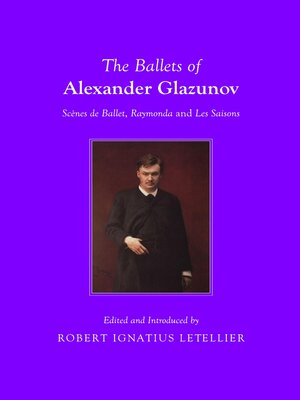The Ballets of Alexander Glazunov
ebook ∣ Scènes de Ballet, Raymonda and Les Saisons
By Robert Ignatius Letellier

Sign up to save your library
With an OverDrive account, you can save your favorite libraries for at-a-glance information about availability. Find out more about OverDrive accounts.
Find this title in Libby, the library reading app by OverDrive.



Search for a digital library with this title
Title found at these libraries:
| Loading... |
Alexander Konstantinovich Glazunov (1865–1936), the Russian composer, is principally associated with his first ballet Raymonda, the apex of his cooperation with the great choreographer Marius Petipa, then in the last years of his illustrious career. Raymonda is still performed in Russia and intermittently in the West. Glazunov, a precocious musical talent from his childhood, was regarded as the inheritor of the Russian nationalist ideals. However, he soon turned to absolute forms of music, rather than the thematically inspired tone paintings so typical of the Mighty Handful. His symphonic compositions are nonetheless full of Russian folk allusion. His emotional world seems to have been centred in the atmosphere of the classical Russian ballet. The movements in his abstract orchestral scores seem to reflect a glamorous, glittering world. He was the composer of four masterful dance compositions: Scènes de Ballet, Op. 52 (1894), Raymonda, Op. 57 (1898), Les Ruses d'Amour, Op. 61 (1900), and The Seasons, Op. 67 (1900). All became major works in the sunset of the Imperial Ballet, and remain landmarks in the history of theatre music for the dance. Glazunov appears to have been a warm and genial man, a firm friend and modest about his considerable accomplishments. As a teacher he in turn exercised considerable influence on the younger generation through his composition classes at the St Petersburg Conservatory, where he also became director. His life was outwardly uneventful, but single-minded in pursuit of his musical ideals. He was full of honours when he died in Paris on 21 March 1936.The suite Scènes de Ballet, Opus 52 in 8 movements, was written in 1894, and published the following year, dedicated to the orchestra of the Russian Opera, St Petersburg. It was first performed at a concert of the Imperial Music Society in 1895, with the composer conducting from the manuscript score. Each section of this work is structured with great confidence, developed with a magisterial certainty, and defined in its own ideal musical character (Introduction, Marionnettes, Mazurka, Scherzo, Pas d'action, Danse orientale, Valse, Polonaise), and shows the composer's instinctive feel for the dance and its various genres.In Raymonda, a romance tale of the Crusades, Glazunov provided a very considerable ballet score, conceived on the broadest scale for an extended scenario. Some of the scenes, and some of the melodies and tone colours of this ballet pay homage to the Tchaikovskian tradition. The story serves as the pretext for a series of divertissements, almost too profuse, intended to show off the virtuosity and special gifts of the famous soloists. Glazunov was inspired to compose agreeable music, always easy to listen to, sometimes rather bland in its melodic facility, but always showing the composer's great mastery of form, harmony and orchestration. It misses the nobility of inner expressiveness and melodic urgency inherent in Tchaikovsky's music. The act 2 finale especially achieves elegance of form and harmonic audacity, and reveals a firm contrapuntal technique. This work has always been able to stimulate the acting abilities of the great ballerinas. In Russia, where it is still danced, there was a revitalizing revival and production in 1900 directed by the choreographer Gorsky at the Bolshoi Theatre in Moscow. After the October Revolution it was often staged, both at the Kirov in Leningrad and at the Bolshoi.The Seasons has no story as such, and unfolds in four scenes as an evocation of the yearly phases of the natural world. Each is represented by a number of episodes, some amorous, others idyllic, but all dominated by the natural cycle of winter sleep, spring awakening, summer...






